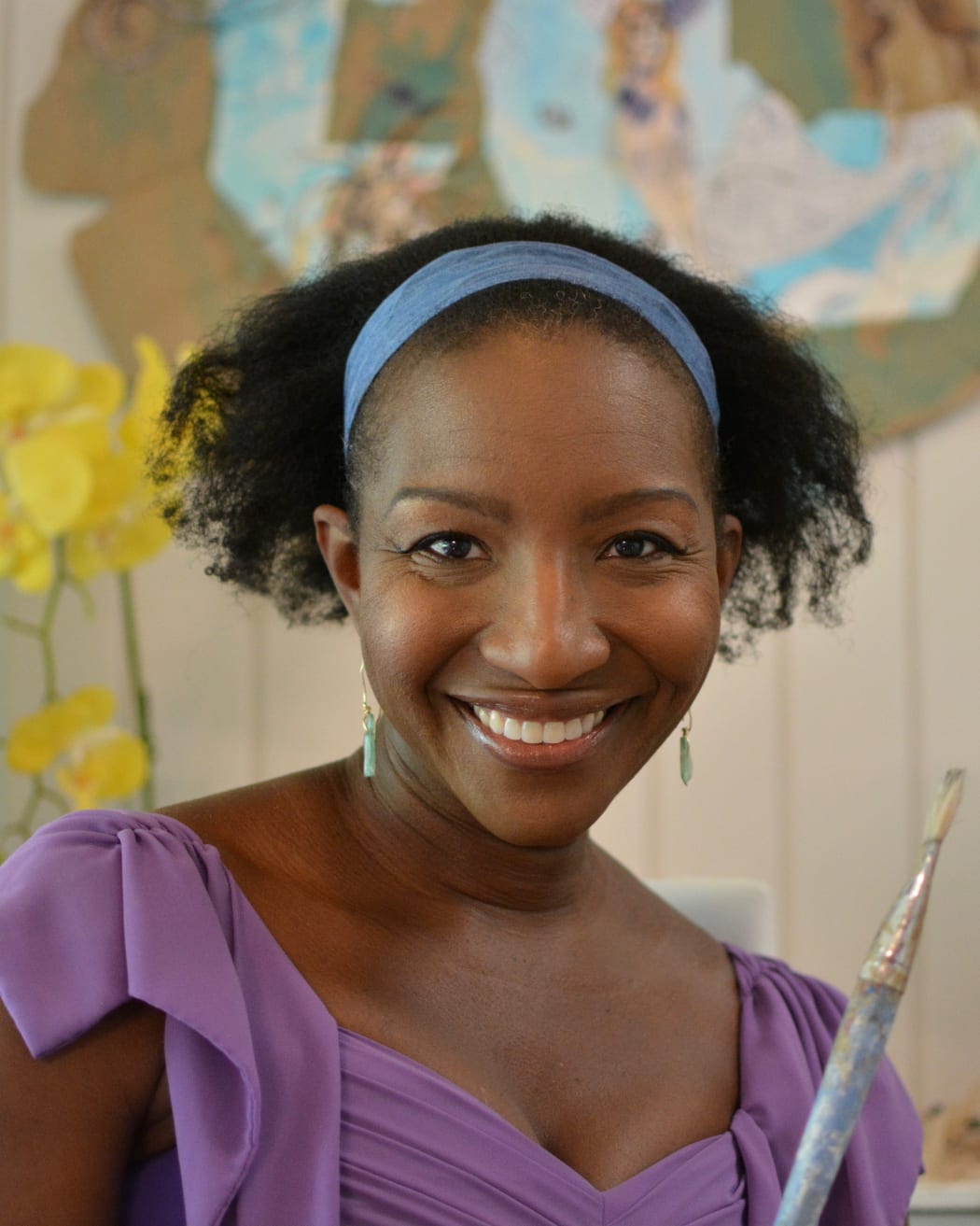
The name Laetitia comes from a Latin word for joy, and artist Laetitia Adam-Rabel is certainly full of it. Affectionately referred to by most, The CAMP Gang included, as "Laeti," the polyfacetic Haitian-American artist radiates a warm energy. She has an inborn type of passion that is equal parts grounded and effervescent, whether she's tackling the insidious forces lurking underneath social structures, collaborating with her bubbly toddler on her newest series: Faussilization, or talking about the pivot from studying fashion design at Parsons to art education at FIU,
"Laeti at Parsons was not an actualized artist. She was a scared, intimidated, young woman who hid the artist she was behind [the idea of being] a would-be designer. I turned 17 my first week of school at Parsons. I thought the only way I could make a living in the arts was by being a "practical artist"-in other words, a designer. That idea started very early in my life. I must have been 6 years old when I started drawing floor-plans and designing clothes, although my passion was for the fine arts.
Present-day Laeti would tell [her] not to give up on her passion, and at the end of the day, the things we are passionate about are the ones most deserving of our attention, and are the things that can bring us the joy that we all seek. Also, Laeti at Parsons was under the impression that she needed to do it all on her own, but in reality, what present-day Laeti knows is that no one does it alone. We all need a support system."
The expansiveness of Laeti's body of work is driven by a deep-rooted need to bare herself, sparing no joys or fears, and carve out her own corner or the world. Her first solo exhibition with The CAMP, titled Origin Not Found, is an exploration of how that process has transformed in tandem with her own identity.
For Laeti, the topics of immigration and assimilation, environment, and the palpable need to survive and thrive, are intertwined with a natural interrogation of culture, her Blackness, motherhood. Mother and Child Three, a color photograph of Laeti and her daughter, who is eye to eye with the audience, can be interpreted as an embodying of the interplay between mother-and-child and the world as it has been, what it might be completely unknown to either of them.
Origin Not Found sees the breadth of Laeti's technical knowledge and experimental nature on display, with pieces ranging from textile and photography to sculpture and video work. Selecting which of her pieces should be graced with a singling out such as, "the most impressive of which," is difficult in an expected way.
"I am proof that there is not much you cannot teach yourself with good videos and a little patience and determination. I won't be mad if my daughter wants to one day attend 'YouTube University'."
Tackling new phases of life isn't easy, either, and what that process looks like can't simply be chalked up an idea of "personal progress" because it requires one to draw upon their pasts-all of them. The works in Origin Not Found are intentionally marked with elements of playfulness and transparency that have come to define an artist who doesn't intend to shy away from life's obstacles, nor the tall order that is rearing her own legacy. Sculptural works from Laeti's Faussilization series, a term invented by the artist to refer to art objects made to resemble historical artifacts, prove an illustration of the complex moving parts of identity, and how they coalesce into mothering oneself and the next generation in a rapidly-evolving world.
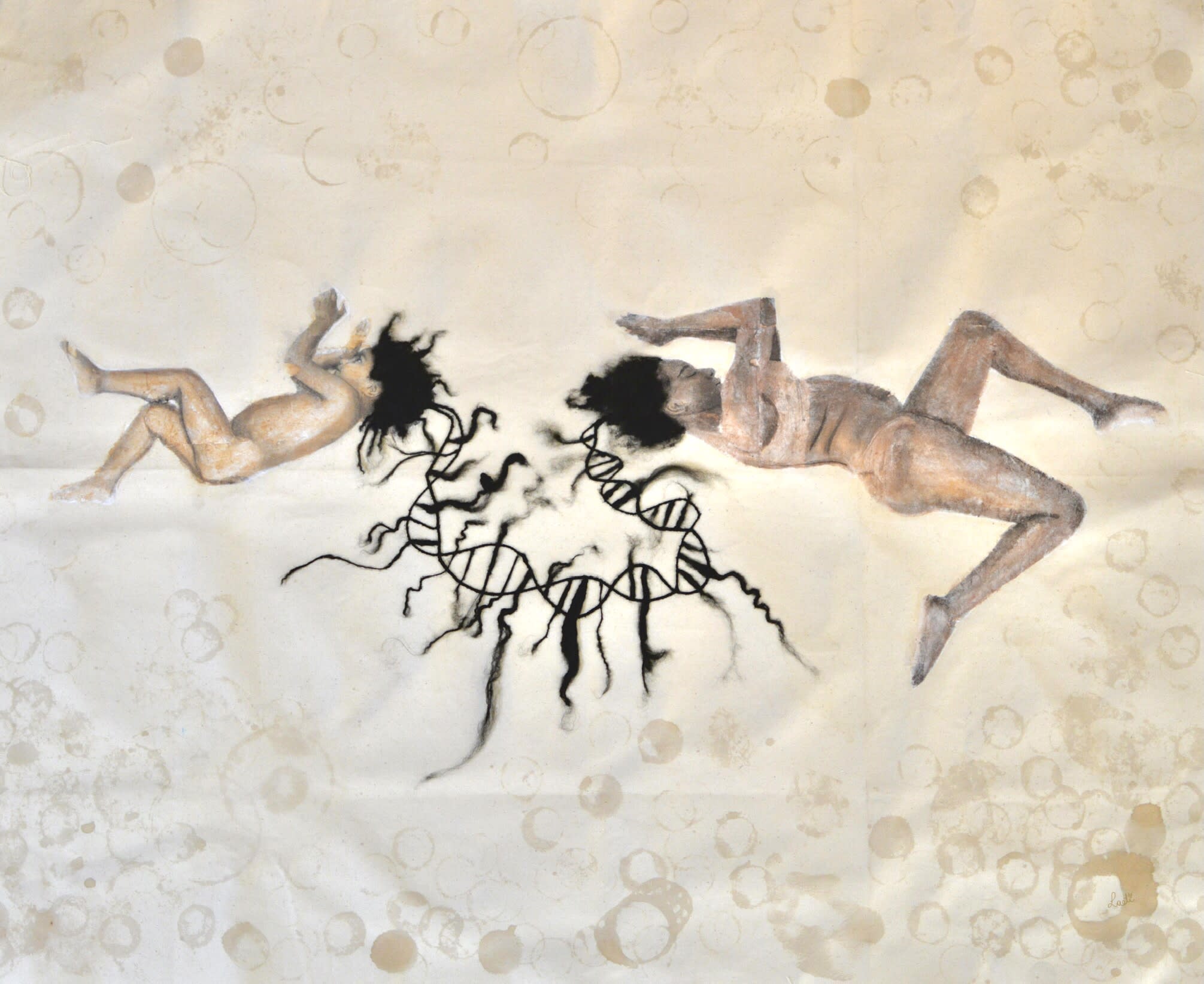
Deoxyribose Nucleic Acid Floating Through Time and Space, 2021. Flocking, image transfer and acrylic on raw canvas. 42 x 34 in.
Can you tell me about your insanely genius ability to work in a variety of media? Where does this come from?
I am blessed to have the education I received but I am also a quick learner. Having studied at Parsons, and before that, at DASH [Design and Architecture Senior High School, in Miami, FL], really gave me a foundation in working in all kinds of media. But even before then, I was a very inquisitive person with a bit of an engineering mind. I grew up close to my grandparents, one who was a convertible automobile stack technician and a mechanic, another a nurse by day and seamstress on her spare time, yet another a professional tailor, and another a seamstress.
Back in the 80's, in Haiti, I attended a French school where, in the 6th grade, I had a computer programming class, which started my love of computers. Back then, at around 10 years of age, I had my first Apple computer, which was given to me by one of my uncles, and I watched my dad and that same uncle-they are kind of geniuses-calling each other on the computer, before the internet was a thing. I remember designing my first computer animation of a flying airplane by typing line after tedious line of code in Basic, one of the computer programming languages back then.
Fast forward a decade or so, I took a class in 3D rendering and animation after I'd already had several years of working with Photoshop and Illustrator in high school and in college. These days, I am very proud of also being an autodidact, I teach myself anything I didn't formally learn, like AfterEffects for video editing. I strongly believe in "YouTube University".
Is there any media that you haven't yet worked with, that you'd like to?
While I have done 3D rendering and animation, I have yet to do 3D printing. I think it would be fun to 3D print some sculptures in the near future.
Do you have a favorite piece in the exhibition?
Yes, I have two favorite pieces: Deoxyribose Nucleic Acid Floating Through Time and Space (above), and Mother and Child Three. I think these two pieces embody a great deal of the topics that are near to my heart: feminist issues, such as being a woman artist, a daughter, a mother; our role in the greater society; my role in shaping my daughter's views of the world and her place in it; and colorism and racism.
Can you tell me a bit about Faussilization?
Faussilization is a big enterprise for me-and still a work in progress. It comprises of works of different media including writing, painting and sculpture, which tell the story of my protagonists, the mermaids.
The mermaid is my chosen icon. No… rather, the mermaid has chosen me to tell the story of how we humans are destroying her beloved home, the ocean. Two of [them] appear in Origin Not Found. One is obviously Awaiting Consciousness, and the other, less obvious mermaid, is Soyla in the painting Soyla, Guardian of Eden. Here is an excerpt from the writing which tells the story of Faussilization:
"During the gender war following the last ice age, women from all parts of the planet were forced to retreat to the uncharted parts of the oceans. Although they had been the victors of all the battles, and ultimately, the whole war, the resulting scarcity of resources, engineered by the dwindling patriarchy through their creation of a monetary system, to which the women wouldn't subscribe, and in an attempt to regain power, led these women and feminists of all genders, to retreat to the oceans… 'Faussilization' is the story of these sirens; who they were, how they came to be fetishized, their evolution into a hybrid species, and their feared, imminent return to reclaim the landmasses."
The title of the series, Faussilization is from a suite of words, which I created by joining "faux" and "fossil," meaning artist-created artifacts, made to look like historical artifacts. The suite of words includes "faussil", "faussilist", "faussilize", and "faussilism".
How does this play into the rest of your body of work?
Faussilization is in line with the rest of my work because it speaks directly to the role of women and feminists in making the world a better place, including for future generations. While working on this series, I am learning more about my strength, and my purpose.
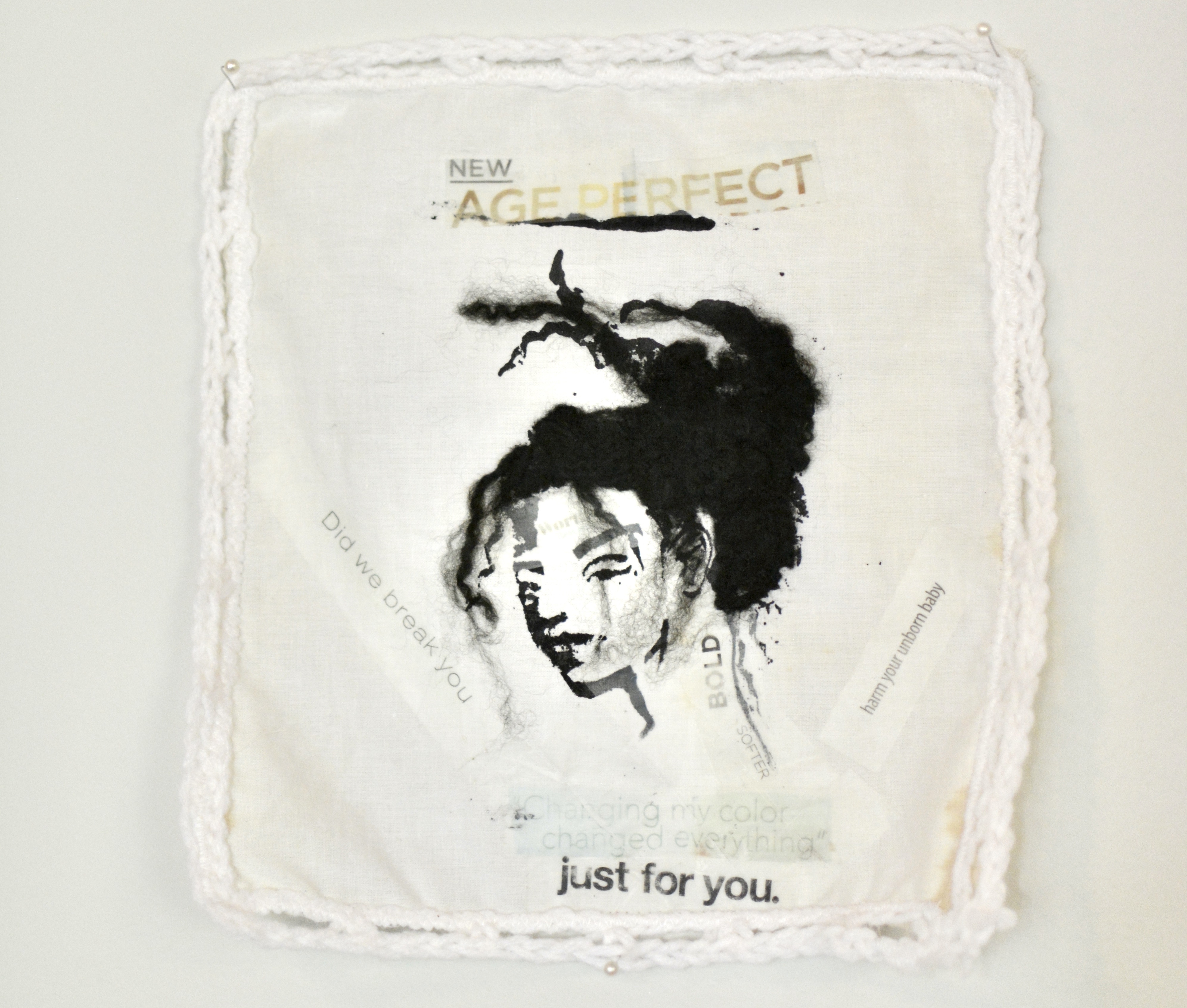
Hair Loom: Changing My Color Changed Everything, 2021. Embroidery, felting and crochet. 11 x 11 in.
I know that for you, your artistic process has a lot to do with your well-being, in the sense that your work is a place for healing as much as it's about self-exploration.
I was a very easily-frightened child. As an adult, I am very prone to anxiety…about anything I can think of. I've had to deal with a lot of trauma. One therapist told me that she thought I suffer from Post Traumatic Stress Disorder, maybe more than anything else.
Making art helps me process that trauma and anxiety in a very palpable, psychosomatic way. Making small clay heads gives me power; flocking with yarn is a direct release of anger and anxiety; working sharp needles into the soft yarn is comforting, but also somewhat aggressive. It's like having a punching bag but at the fine motor level. My photographic work allows me the escape by creating alternate realities as well alter-egos.
Can you talk to me about the video pieces in this exhibition?
The video pieces are actually very personal. Wounded Voices, where I show up in a blue face, is about being a girl, turning into a woman, and the different insults and assumptions that we have to contend with. This one is a bit autobiographical.
Stoned! Woman, where I am on the beach at about 6 months into my pregnancy, was me expressing my fears about black maternal mortality. Many people don't know that Black mothers' death rate is four times that of their counterparts of other ethnic backgrounds, and of preventable complications. This occurrence is not just due to negligence, but rather to systemic racism-it's well-documented. NPR ran a bit on it, ironically during the time while I was pregnant.
Together We Harness and Fallen Dancer are about the need to decolonize the arts, from ballet, to super-heroines in movies. But the former, is also about passing down to young girls the tools they need to be strong women in this world.
What does your studio look like?
My "studio" is my kitchen table and the kitchen counters. At each mealtime, I have to pack it all up, or shuffle my work around to make room for the family to eat together. It's less than ideal, for sure. I do, however, manage to set a tone conducive to creativity with music. I listen to tracks from Ibeyi, to Flavia Coelho, to The White Stripes, to Pharrell and everything in between. I have a very eclectic taste in music.
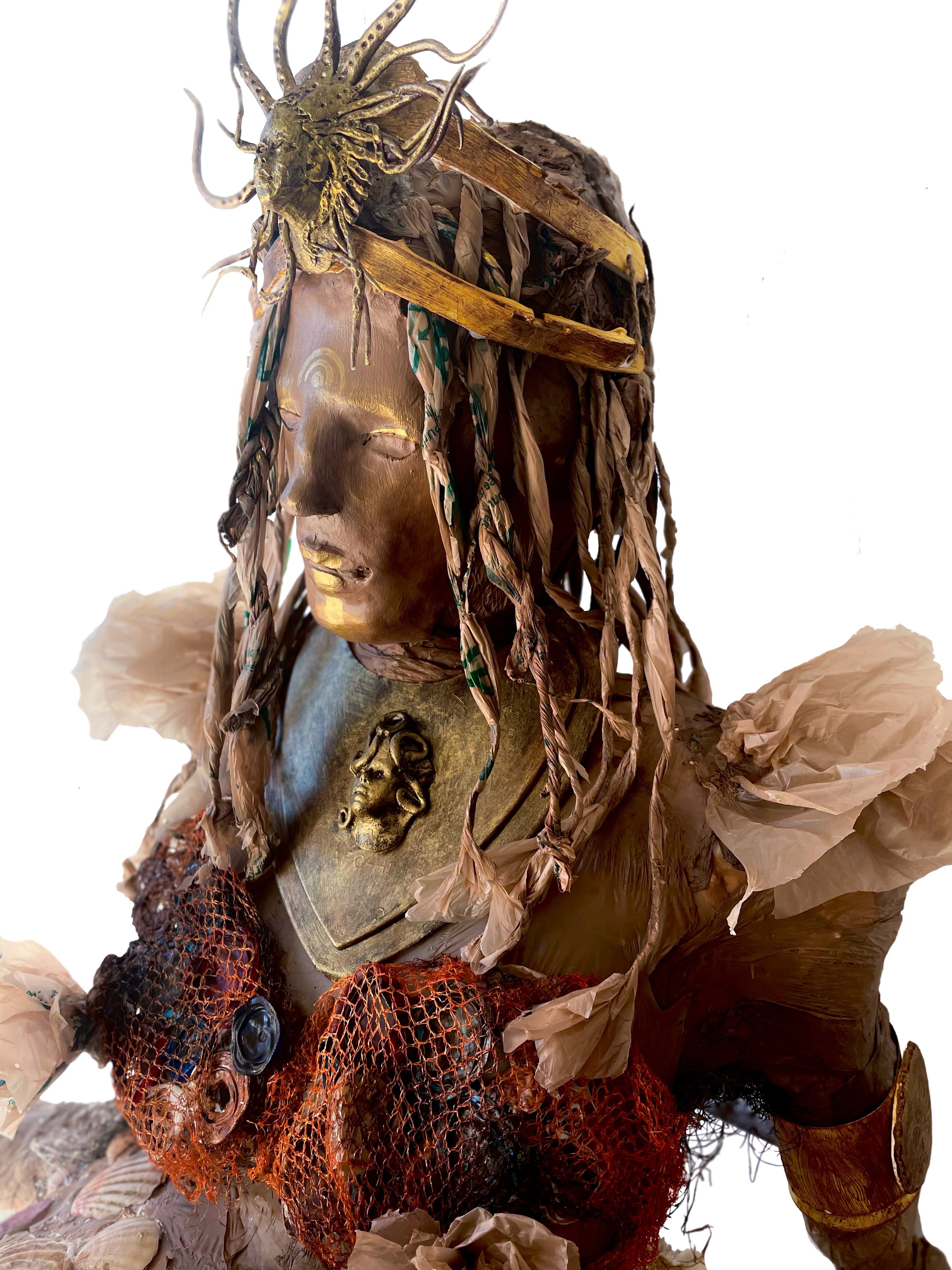
Awaiting Consciousness, 2022. Plaster, repurposed plastic shopping bags, bottle caps, produce mesh bags, other repurposed mesh bags, other repurposed plastic packaging, polymer clay, shells and acrylic. 36 × 60 × 28 in.
This exhibition resonates with me, and others like you and I, because it's a reflection of the complex intersection of identities, and all of their moving parts, in the immigrant experience. It's so much more of a celebration of the worlds you've had to go through in order to get to where you are now rather than this anguished looking back at where things have gone wrong. What are the moving parts present in this exhibition?
Some of the moving parts are self-parenting my inner child, while also parenting my daughter; to create healthier connections and better understand others, and myself; healing from the loss of my closest grandmother as well as the loss of my childhood home; asserting my feminine power and overcoming past relationship trauma while being a loving wife to my husband; and being a loving, helpful daughter to my aging parents.
Would you say that you're someone who seeks out the positive aspect of all things?
I will say that I am tenacious. I am not a quitter when it comes to things about which I am passionate.
Where does your perspective root itself?
I think my belief in myself has brought me where I am now. Being blind and deaf to any lack of support and being stubborn has served me well.
Being a child immigrant comes with a lot of bittersweetness, doesn't it? I find that there's this internal tug-of-war between the adult and that inner child that remembers who you could've been. It's almost like, in my imagination, at least, we have the ability to actively engage with all of our identities, and in a sick way, we're even able to engage with them selectively. Do you have any treasured memories from Haiti that you keep with you as an adult?
Some of my fondest memories of Haiti are playing hooky from elementary school at my maternal grandmother's house, swimming in a concrete basin she had in her backyard that I thought was a pool.
Also, I loved spending weekends at my paternal grandmother's beach. That was the best. Drinking coconut water from the husk on the beach with my cousins.
Does this show up in your work?
Not at all. A lot of my work, is working through trauma. So I think these safe, good memories don't show up, for now anyway. There is one exception, which is my obsession with the mermaid. The love of the water that I carried from childhood does show up through her.
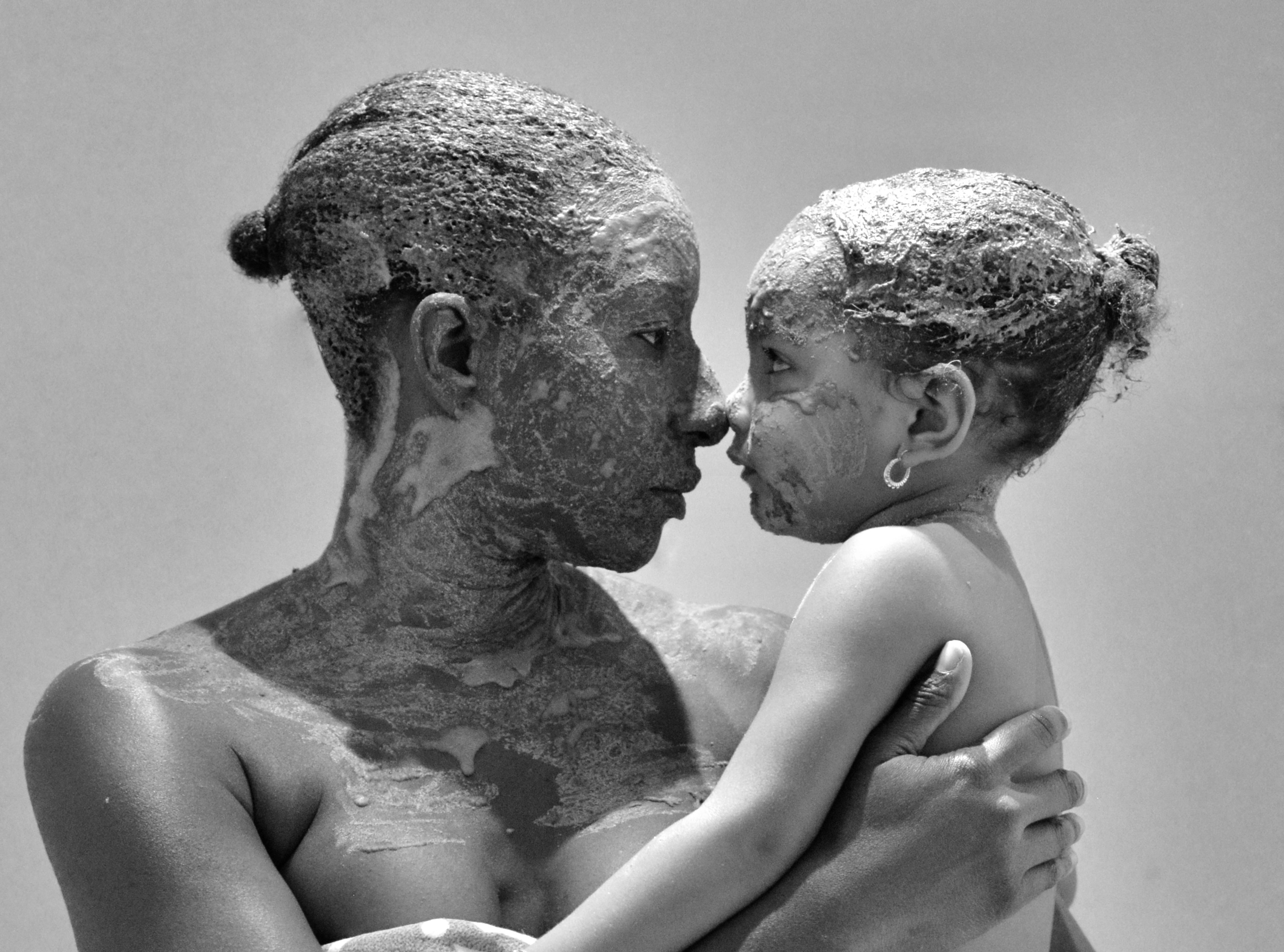
Mother and Child Too, 2021. Photography print on printmaking paper. 18 × 24 in.
Is there a reason for which you've included your daughter as a collaborator as much as you have in these recent works?
She is an amazing, intuitive artist, who is helping me work through a lot of my childhood trauma as we play and make art together. I think it is only fair I give her proper credit. I feel that, too often, children's points of view are ignored. Children actually have a wealth of wisdom, if we only slow down and listen.
How do you think this will play a role in her foundation?
I want her to feel heard, unlike what my experience has too often been. Also, I want her to have the exposure to the life of an artist. Whether she embraces it, or decides she wants nothing to do with it. I homeschool her for the time being, and part of her schooling is an apprenticeship with mommy.
I think that it's safe to say that women aren't any longer expected to responsible for nothing else but domestic "duty." But, of course, that's not to say that, for one, we don't have responsibilities to our family, nor that we don't put this pressure on ourselves, especially as women from Caribbean cultures, simply because of how we were raised. How would you describe the balance, or at least the process of balancing, of all of your chosen "hats," so to speak?
Finding the right balance is sometimes tricky. I have written a weekly schedule where certain days are for homeschooling and library and museum outings, and other days are for art-making and apprenticeship, and a couple of days are for household chores. I would be remiss, however, not to mention that my husband almost singlehandedly cooks dinner along with certain other chores, as well as working full-time, to allow me the time and space to develop my body of work. It is a sacrifice on his behalf, that I don't take for granted, given that he is himself a visual artist.
How do you think this manifests in your work now?
I think the different "hats" I wear permeate into my work through and through. It is impossible to separate these from my artwork. For example, as a mother, I worry about keeping my daughter safe. I once had a horrible nightmare that there was a tsunami, and our car was sinking on the road that had become one with the ocean, with me and my daughter in it. This was one thing that gave me the impetus to make the life-size mermaid. [Awaiting Consciousness] is a warning, and a plea to us all to change our consumption habits to help slow down the effects on the environment. I like to think that if we're ever in that predicament, that the mermaid, Mother Nature, Mami Wata, Simbi, Yemaya, and Oshun, will have mercy on us. While I do pray to God, I am a little burnt on what male leadership has brought us to. So I feel it's time to revere the female and the male alike.
